Wireless Network Security
VerifiedAdded on 2023/06/07
|12
|3480
|114
AI Summary
This report explains the fundamental concept of wireless networks, various challenges faced in this type of communication system, methods to avoid security problems, and their advantages and disadvantages.
Contribute Materials
Your contribution can guide someone’s learning journey. Share your
documents today.
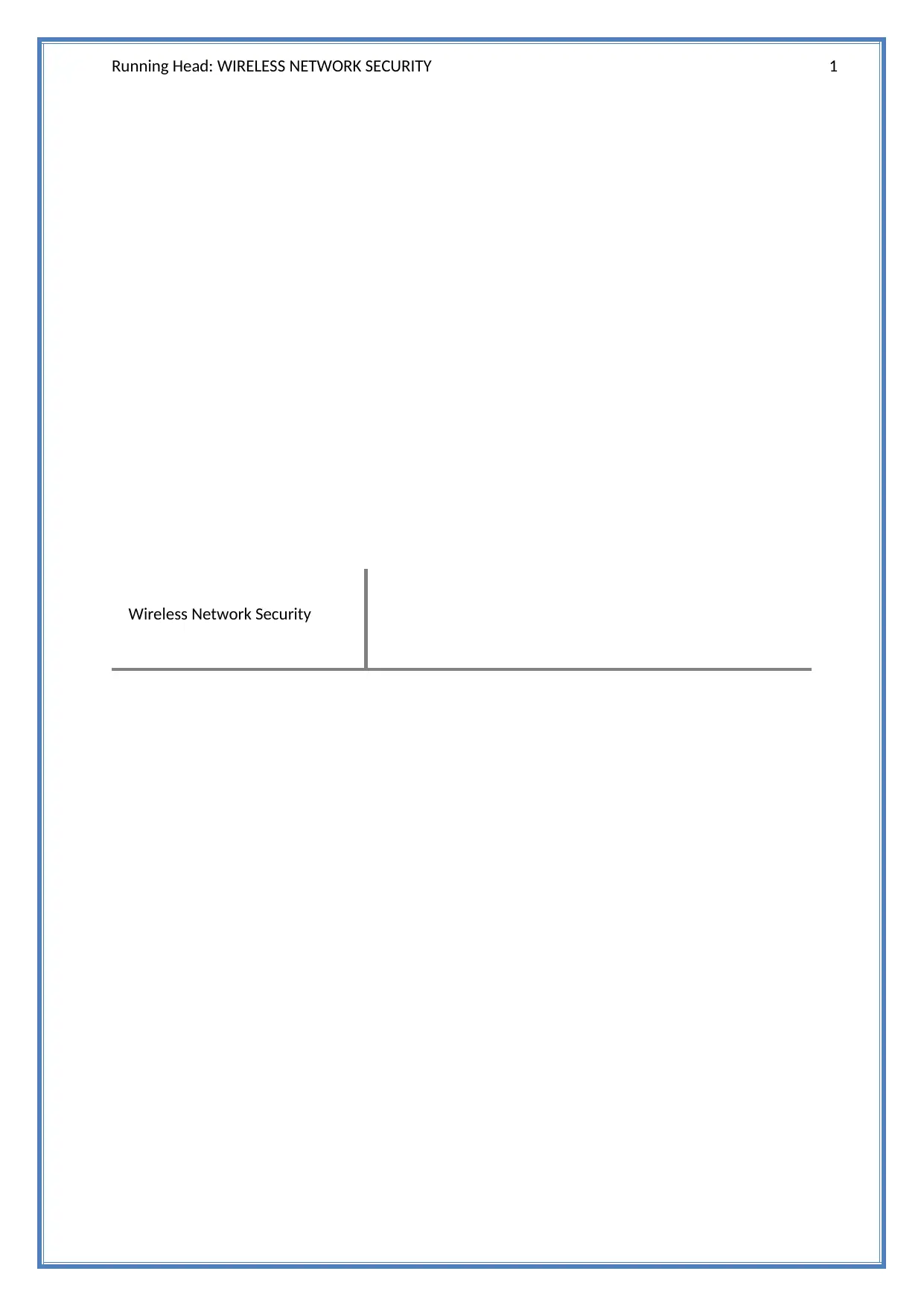
Running Head: WIRELESS NETWORK SECURITY 1
Wireless Network Security
Wireless Network Security
Secure Best Marks with AI Grader
Need help grading? Try our AI Grader for instant feedback on your assignments.
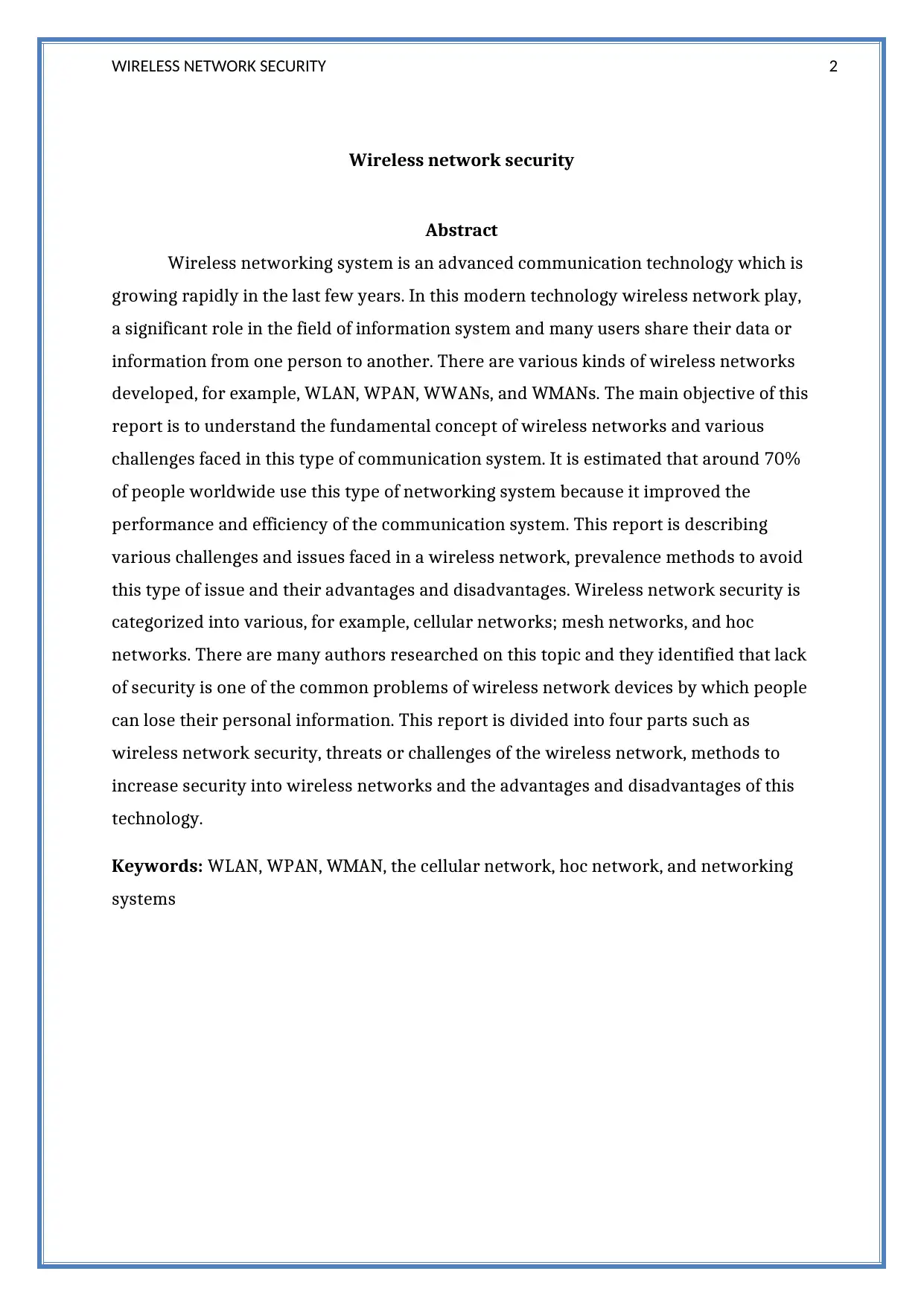
WIRELESS NETWORK SECURITY 2
Wireless network security
Abstract
Wireless networking system is an advanced communication technology which is
growing rapidly in the last few years. In this modern technology wireless network play,
a significant role in the field of information system and many users share their data or
information from one person to another. There are various kinds of wireless networks
developed, for example, WLAN, WPAN, WWANs, and WMANs. The main objective of this
report is to understand the fundamental concept of wireless networks and various
challenges faced in this type of communication system. It is estimated that around 70%
of people worldwide use this type of networking system because it improved the
performance and efficiency of the communication system. This report is describing
various challenges and issues faced in a wireless network, prevalence methods to avoid
this type of issue and their advantages and disadvantages. Wireless network security is
categorized into various, for example, cellular networks; mesh networks, and hoc
networks. There are many authors researched on this topic and they identified that lack
of security is one of the common problems of wireless network devices by which people
can lose their personal information. This report is divided into four parts such as
wireless network security, threats or challenges of the wireless network, methods to
increase security into wireless networks and the advantages and disadvantages of this
technology.
Keywords: WLAN, WPAN, WMAN, the cellular network, hoc network, and networking
systems
Wireless network security
Abstract
Wireless networking system is an advanced communication technology which is
growing rapidly in the last few years. In this modern technology wireless network play,
a significant role in the field of information system and many users share their data or
information from one person to another. There are various kinds of wireless networks
developed, for example, WLAN, WPAN, WWANs, and WMANs. The main objective of this
report is to understand the fundamental concept of wireless networks and various
challenges faced in this type of communication system. It is estimated that around 70%
of people worldwide use this type of networking system because it improved the
performance and efficiency of the communication system. This report is describing
various challenges and issues faced in a wireless network, prevalence methods to avoid
this type of issue and their advantages and disadvantages. Wireless network security is
categorized into various, for example, cellular networks; mesh networks, and hoc
networks. There are many authors researched on this topic and they identified that lack
of security is one of the common problems of wireless network devices by which people
can lose their personal information. This report is divided into four parts such as
wireless network security, threats or challenges of the wireless network, methods to
increase security into wireless networks and the advantages and disadvantages of this
technology.
Keywords: WLAN, WPAN, WMAN, the cellular network, hoc network, and networking
systems

WIRELESS NETWORK SECURITY 3
Table of Contents
Abstract.................................................................................................................................................2
Introduction...........................................................................................................................................4
Overview of Wireless network security.................................................................................................4
Technologies used in Wireless network security...................................................................................5
Wireless local area network..............................................................................................................5
Access point.......................................................................................................................................5
Wired equivalent privacy (WEP)........................................................................................................5
Wi-Fi Protected Access (WPA)...........................................................................................................5
Challenges and issues faced in wireless networks.................................................................................6
Rogue Access Points/Ad-Hoc Networks.............................................................................................6
Denial of Service................................................................................................................................6
Configuration Problems.....................................................................................................................7
Passive Capturing...........................................................................................................................7
Gaps in the literature.............................................................................................................................7
Methods to avoid security problems in wireless networks...................................................................8
Advantages of Wireless networks.........................................................................................................9
Disadvantages of wireless networks......................................................................................................9
Future research.....................................................................................................................................9
Conclusion.............................................................................................................................................9
References...........................................................................................................................................11
Table of Contents
Abstract.................................................................................................................................................2
Introduction...........................................................................................................................................4
Overview of Wireless network security.................................................................................................4
Technologies used in Wireless network security...................................................................................5
Wireless local area network..............................................................................................................5
Access point.......................................................................................................................................5
Wired equivalent privacy (WEP)........................................................................................................5
Wi-Fi Protected Access (WPA)...........................................................................................................5
Challenges and issues faced in wireless networks.................................................................................6
Rogue Access Points/Ad-Hoc Networks.............................................................................................6
Denial of Service................................................................................................................................6
Configuration Problems.....................................................................................................................7
Passive Capturing...........................................................................................................................7
Gaps in the literature.............................................................................................................................7
Methods to avoid security problems in wireless networks...................................................................8
Advantages of Wireless networks.........................................................................................................9
Disadvantages of wireless networks......................................................................................................9
Future research.....................................................................................................................................9
Conclusion.............................................................................................................................................9
References...........................................................................................................................................11

WIRELESS NETWORK SECURITY 4
Introduction
Wireless is an advanced technology of wired and it reduced many drawbacks of
such as long distance communication and flexibility. The main strength of this network
system is that it can be used for long distance interaction purpose and people can
communicate with peripheral devices (Garg, 2011). Between 2000 and 2017, various
kinds of wireless network protocols are developed, for example, Wi-FI, Bluetooth,
Zigbee, and LTE. The overall band spectrums of wireless networks are very large rather
than other network devices. In this modern generation, many organizations and
communities use wireless protocols to share data files from one device to another
(Burbank, 2008). This report is explaining various challenges and issues occur in
wireless networks and methods to avoid this problem.
Overview of Wireless network security
Security of wireless network is defined as a process of implementing and
designing of security plans for computer systems. It is a platform where any person can
improve the security of their wireless devices. It is observed that in wireless networks
signal or information can be easily hacked by attacker and they use complex algorithm
process to block user personal server. In this type of system data signals transmitted
into free space by which attackers can easily capture these signals and they can encrypt
our personal information (Burbank, 2008). There are main two security systems which
can be used to avoid threats and risks of wireless network security, for example, WEP
(wired equivalent policy) and WPA (wireless protected access). Wireless networking
system is also called the remote system in which signal or information is transmitted
from transmitter to receiver without using any connecting wires.
Therefore this process can be used to share data over long distance and in which
both transmitter and receiver have used the concept of the wireless system. In the last
few years, the problem of security in wireless devices is growing very fast and hackers
can easily enter into user peripheral devices by which many organizations are suffering
from the issue of cyber-crimes. WLAN, WMAN, WPAN, and WWAN all these are wireless
components by which any person can send and receive their data files from one device
to another peripheral device.
Introduction
Wireless is an advanced technology of wired and it reduced many drawbacks of
such as long distance communication and flexibility. The main strength of this network
system is that it can be used for long distance interaction purpose and people can
communicate with peripheral devices (Garg, 2011). Between 2000 and 2017, various
kinds of wireless network protocols are developed, for example, Wi-FI, Bluetooth,
Zigbee, and LTE. The overall band spectrums of wireless networks are very large rather
than other network devices. In this modern generation, many organizations and
communities use wireless protocols to share data files from one device to another
(Burbank, 2008). This report is explaining various challenges and issues occur in
wireless networks and methods to avoid this problem.
Overview of Wireless network security
Security of wireless network is defined as a process of implementing and
designing of security plans for computer systems. It is a platform where any person can
improve the security of their wireless devices. It is observed that in wireless networks
signal or information can be easily hacked by attacker and they use complex algorithm
process to block user personal server. In this type of system data signals transmitted
into free space by which attackers can easily capture these signals and they can encrypt
our personal information (Burbank, 2008). There are main two security systems which
can be used to avoid threats and risks of wireless network security, for example, WEP
(wired equivalent policy) and WPA (wireless protected access). Wireless networking
system is also called the remote system in which signal or information is transmitted
from transmitter to receiver without using any connecting wires.
Therefore this process can be used to share data over long distance and in which
both transmitter and receiver have used the concept of the wireless system. In the last
few years, the problem of security in wireless devices is growing very fast and hackers
can easily enter into user peripheral devices by which many organizations are suffering
from the issue of cyber-crimes. WLAN, WMAN, WPAN, and WWAN all these are wireless
components by which any person can send and receive their data files from one device
to another peripheral device.
Secure Best Marks with AI Grader
Need help grading? Try our AI Grader for instant feedback on your assignments.
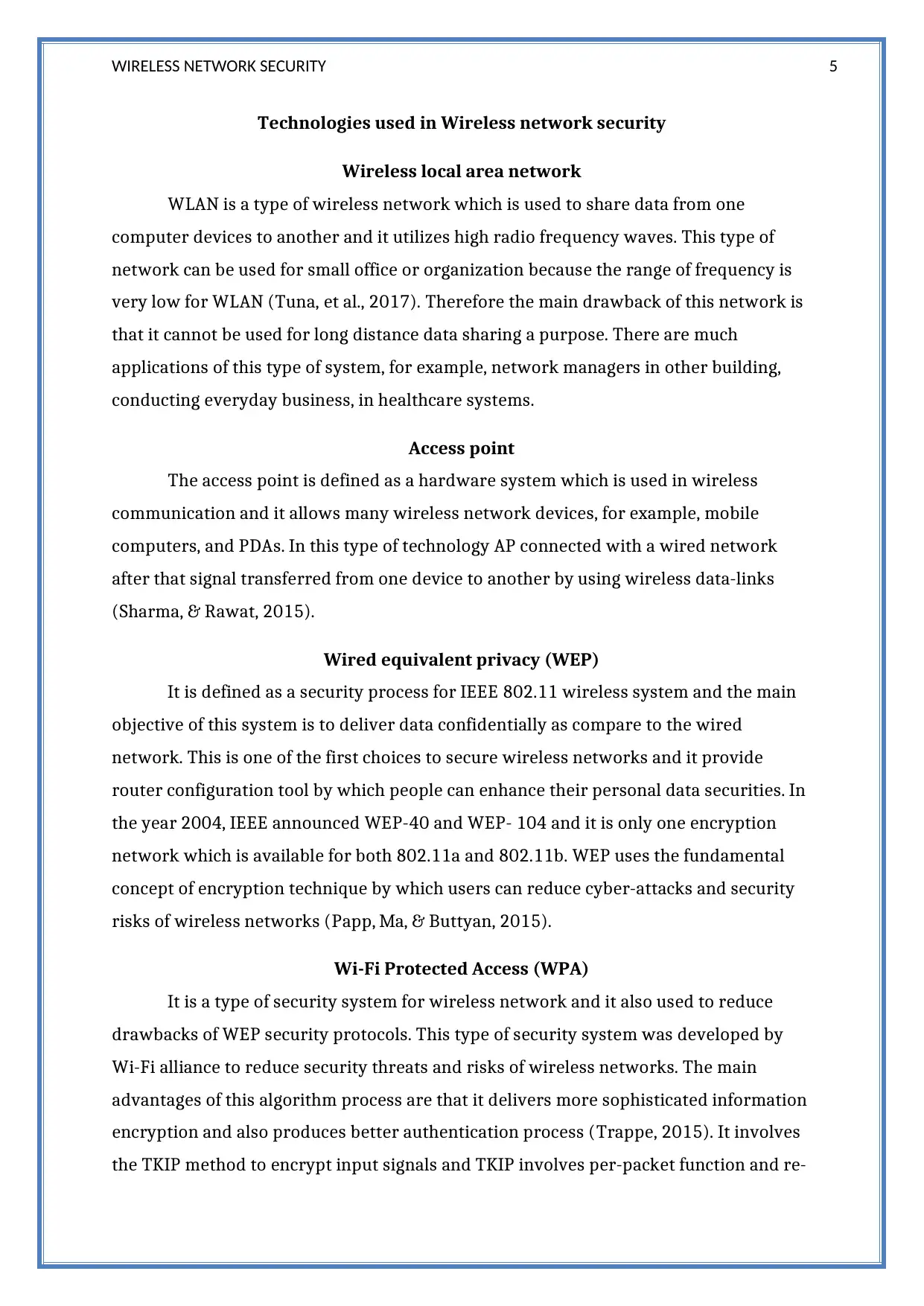
WIRELESS NETWORK SECURITY 5
Technologies used in Wireless network security
Wireless local area network
WLAN is a type of wireless network which is used to share data from one
computer devices to another and it utilizes high radio frequency waves. This type of
network can be used for small office or organization because the range of frequency is
very low for WLAN (Tuna, et al., 2017). Therefore the main drawback of this network is
that it cannot be used for long distance data sharing a purpose. There are much
applications of this type of system, for example, network managers in other building,
conducting everyday business, in healthcare systems.
Access point
The access point is defined as a hardware system which is used in wireless
communication and it allows many wireless network devices, for example, mobile
computers, and PDAs. In this type of technology AP connected with a wired network
after that signal transferred from one device to another by using wireless data-links
(Sharma, & Rawat, 2015).
Wired equivalent privacy (WEP)
It is defined as a security process for IEEE 802.11 wireless system and the main
objective of this system is to deliver data confidentially as compare to the wired
network. This is one of the first choices to secure wireless networks and it provide
router configuration tool by which people can enhance their personal data securities. In
the year 2004, IEEE announced WEP-40 and WEP- 104 and it is only one encryption
network which is available for both 802.11a and 802.11b. WEP uses the fundamental
concept of encryption technique by which users can reduce cyber-attacks and security
risks of wireless networks (Papp, Ma, & Buttyan, 2015).
Wi-Fi Protected Access (WPA)
It is a type of security system for wireless network and it also used to reduce
drawbacks of WEP security protocols. This type of security system was developed by
Wi-Fi alliance to reduce security threats and risks of wireless networks. The main
advantages of this algorithm process are that it delivers more sophisticated information
encryption and also produces better authentication process (Trappe, 2015). It involves
the TKIP method to encrypt input signals and TKIP involves per-packet function and re-
Technologies used in Wireless network security
Wireless local area network
WLAN is a type of wireless network which is used to share data from one
computer devices to another and it utilizes high radio frequency waves. This type of
network can be used for small office or organization because the range of frequency is
very low for WLAN (Tuna, et al., 2017). Therefore the main drawback of this network is
that it cannot be used for long distance data sharing a purpose. There are much
applications of this type of system, for example, network managers in other building,
conducting everyday business, in healthcare systems.
Access point
The access point is defined as a hardware system which is used in wireless
communication and it allows many wireless network devices, for example, mobile
computers, and PDAs. In this type of technology AP connected with a wired network
after that signal transferred from one device to another by using wireless data-links
(Sharma, & Rawat, 2015).
Wired equivalent privacy (WEP)
It is defined as a security process for IEEE 802.11 wireless system and the main
objective of this system is to deliver data confidentially as compare to the wired
network. This is one of the first choices to secure wireless networks and it provide
router configuration tool by which people can enhance their personal data securities. In
the year 2004, IEEE announced WEP-40 and WEP- 104 and it is only one encryption
network which is available for both 802.11a and 802.11b. WEP uses the fundamental
concept of encryption technique by which users can reduce cyber-attacks and security
risks of wireless networks (Papp, Ma, & Buttyan, 2015).
Wi-Fi Protected Access (WPA)
It is a type of security system for wireless network and it also used to reduce
drawbacks of WEP security protocols. This type of security system was developed by
Wi-Fi alliance to reduce security threats and risks of wireless networks. The main
advantages of this algorithm process are that it delivers more sophisticated information
encryption and also produces better authentication process (Trappe, 2015). It involves
the TKIP method to encrypt input signals and TKIP involves per-packet function and re-
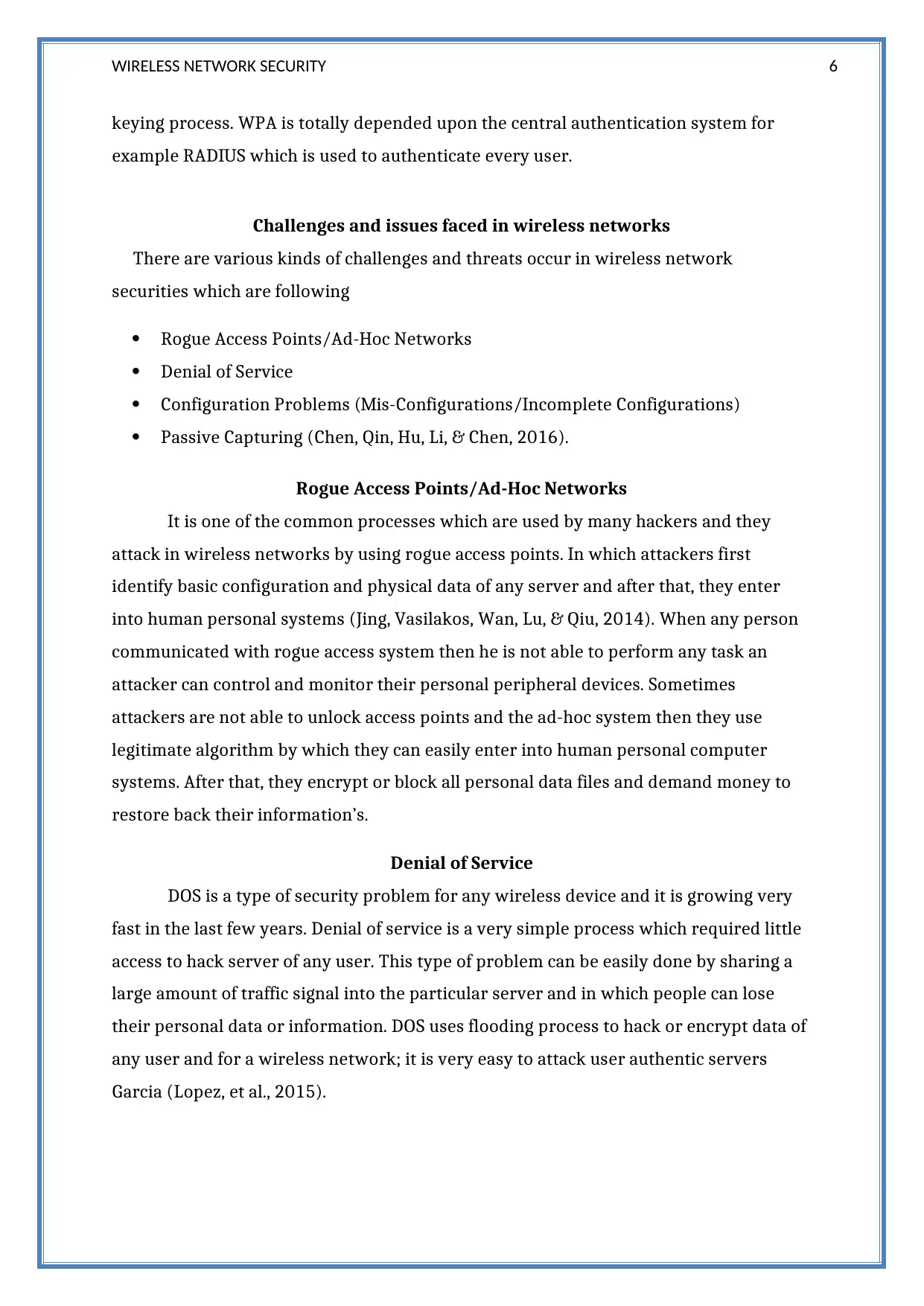
WIRELESS NETWORK SECURITY 6
keying process. WPA is totally depended upon the central authentication system for
example RADIUS which is used to authenticate every user.
Challenges and issues faced in wireless networks
There are various kinds of challenges and threats occur in wireless network
securities which are following
Rogue Access Points/Ad-Hoc Networks
Denial of Service
Configuration Problems (Mis-Configurations/Incomplete Configurations)
Passive Capturing (Chen, Qin, Hu, Li, & Chen, 2016).
Rogue Access Points/Ad-Hoc Networks
It is one of the common processes which are used by many hackers and they
attack in wireless networks by using rogue access points. In which attackers first
identify basic configuration and physical data of any server and after that, they enter
into human personal systems (Jing, Vasilakos, Wan, Lu, & Qiu, 2014). When any person
communicated with rogue access system then he is not able to perform any task an
attacker can control and monitor their personal peripheral devices. Sometimes
attackers are not able to unlock access points and the ad-hoc system then they use
legitimate algorithm by which they can easily enter into human personal computer
systems. After that, they encrypt or block all personal data files and demand money to
restore back their information’s.
Denial of Service
DOS is a type of security problem for any wireless device and it is growing very
fast in the last few years. Denial of service is a very simple process which required little
access to hack server of any user. This type of problem can be easily done by sharing a
large amount of traffic signal into the particular server and in which people can lose
their personal data or information. DOS uses flooding process to hack or encrypt data of
any user and for a wireless network; it is very easy to attack user authentic servers
Garcia (Lopez, et al., 2015).
keying process. WPA is totally depended upon the central authentication system for
example RADIUS which is used to authenticate every user.
Challenges and issues faced in wireless networks
There are various kinds of challenges and threats occur in wireless network
securities which are following
Rogue Access Points/Ad-Hoc Networks
Denial of Service
Configuration Problems (Mis-Configurations/Incomplete Configurations)
Passive Capturing (Chen, Qin, Hu, Li, & Chen, 2016).
Rogue Access Points/Ad-Hoc Networks
It is one of the common processes which are used by many hackers and they
attack in wireless networks by using rogue access points. In which attackers first
identify basic configuration and physical data of any server and after that, they enter
into human personal systems (Jing, Vasilakos, Wan, Lu, & Qiu, 2014). When any person
communicated with rogue access system then he is not able to perform any task an
attacker can control and monitor their personal peripheral devices. Sometimes
attackers are not able to unlock access points and the ad-hoc system then they use
legitimate algorithm by which they can easily enter into human personal computer
systems. After that, they encrypt or block all personal data files and demand money to
restore back their information’s.
Denial of Service
DOS is a type of security problem for any wireless device and it is growing very
fast in the last few years. Denial of service is a very simple process which required little
access to hack server of any user. This type of problem can be easily done by sharing a
large amount of traffic signal into the particular server and in which people can lose
their personal data or information. DOS uses flooding process to hack or encrypt data of
any user and for a wireless network; it is very easy to attack user authentic servers
Garcia (Lopez, et al., 2015).
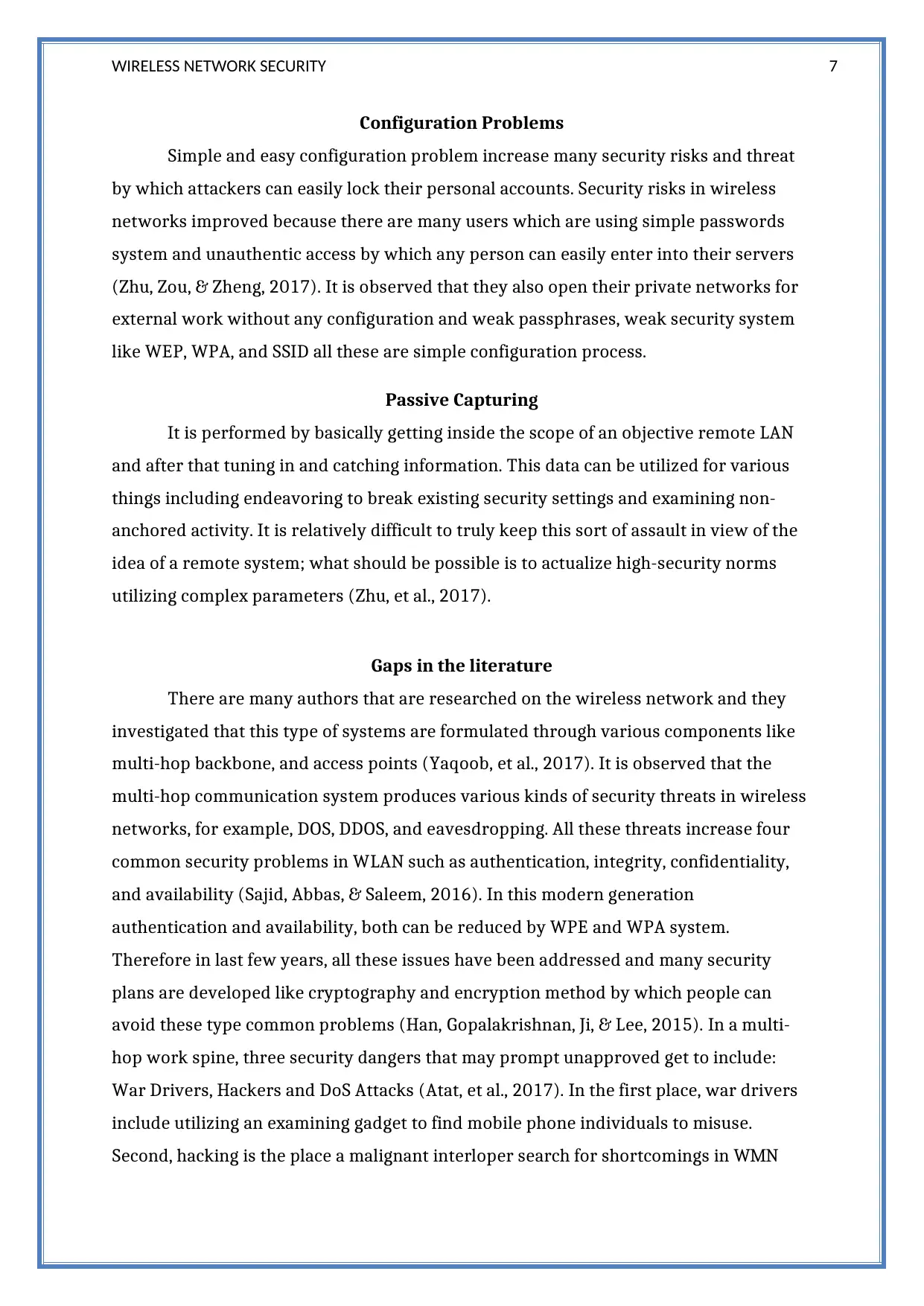
WIRELESS NETWORK SECURITY 7
Configuration Problems
Simple and easy configuration problem increase many security risks and threat
by which attackers can easily lock their personal accounts. Security risks in wireless
networks improved because there are many users which are using simple passwords
system and unauthentic access by which any person can easily enter into their servers
(Zhu, Zou, & Zheng, 2017). It is observed that they also open their private networks for
external work without any configuration and weak passphrases, weak security system
like WEP, WPA, and SSID all these are simple configuration process.
Passive Capturing
It is performed by basically getting inside the scope of an objective remote LAN
and after that tuning in and catching information. This data can be utilized for various
things including endeavoring to break existing security settings and examining non-
anchored activity. It is relatively difficult to truly keep this sort of assault in view of the
idea of a remote system; what should be possible is to actualize high-security norms
utilizing complex parameters (Zhu, et al., 2017).
Gaps in the literature
There are many authors that are researched on the wireless network and they
investigated that this type of systems are formulated through various components like
multi-hop backbone, and access points (Yaqoob, et al., 2017). It is observed that the
multi-hop communication system produces various kinds of security threats in wireless
networks, for example, DOS, DDOS, and eavesdropping. All these threats increase four
common security problems in WLAN such as authentication, integrity, confidentiality,
and availability (Sajid, Abbas, & Saleem, 2016). In this modern generation
authentication and availability, both can be reduced by WPE and WPA system.
Therefore in last few years, all these issues have been addressed and many security
plans are developed like cryptography and encryption method by which people can
avoid these type common problems (Han, Gopalakrishnan, Ji, & Lee, 2015). In a multi-
hop work spine, three security dangers that may prompt unapproved get to include:
War Drivers, Hackers and DoS Attacks (Atat, et al., 2017). In the first place, war drivers
include utilizing an examining gadget to find mobile phone individuals to misuse.
Second, hacking is the place a malignant interloper search for shortcomings in WMN
Configuration Problems
Simple and easy configuration problem increase many security risks and threat
by which attackers can easily lock their personal accounts. Security risks in wireless
networks improved because there are many users which are using simple passwords
system and unauthentic access by which any person can easily enter into their servers
(Zhu, Zou, & Zheng, 2017). It is observed that they also open their private networks for
external work without any configuration and weak passphrases, weak security system
like WEP, WPA, and SSID all these are simple configuration process.
Passive Capturing
It is performed by basically getting inside the scope of an objective remote LAN
and after that tuning in and catching information. This data can be utilized for various
things including endeavoring to break existing security settings and examining non-
anchored activity. It is relatively difficult to truly keep this sort of assault in view of the
idea of a remote system; what should be possible is to actualize high-security norms
utilizing complex parameters (Zhu, et al., 2017).
Gaps in the literature
There are many authors that are researched on the wireless network and they
investigated that this type of systems are formulated through various components like
multi-hop backbone, and access points (Yaqoob, et al., 2017). It is observed that the
multi-hop communication system produces various kinds of security threats in wireless
networks, for example, DOS, DDOS, and eavesdropping. All these threats increase four
common security problems in WLAN such as authentication, integrity, confidentiality,
and availability (Sajid, Abbas, & Saleem, 2016). In this modern generation
authentication and availability, both can be reduced by WPE and WPA system.
Therefore in last few years, all these issues have been addressed and many security
plans are developed like cryptography and encryption method by which people can
avoid these type common problems (Han, Gopalakrishnan, Ji, & Lee, 2015). In a multi-
hop work spine, three security dangers that may prompt unapproved get to include:
War Drivers, Hackers and DoS Attacks (Atat, et al., 2017). In the first place, war drivers
include utilizing an examining gadget to find mobile phone individuals to misuse.
Second, hacking is the place a malignant interloper search for shortcomings in WMN
Paraphrase This Document
Need a fresh take? Get an instant paraphrase of this document with our AI Paraphraser
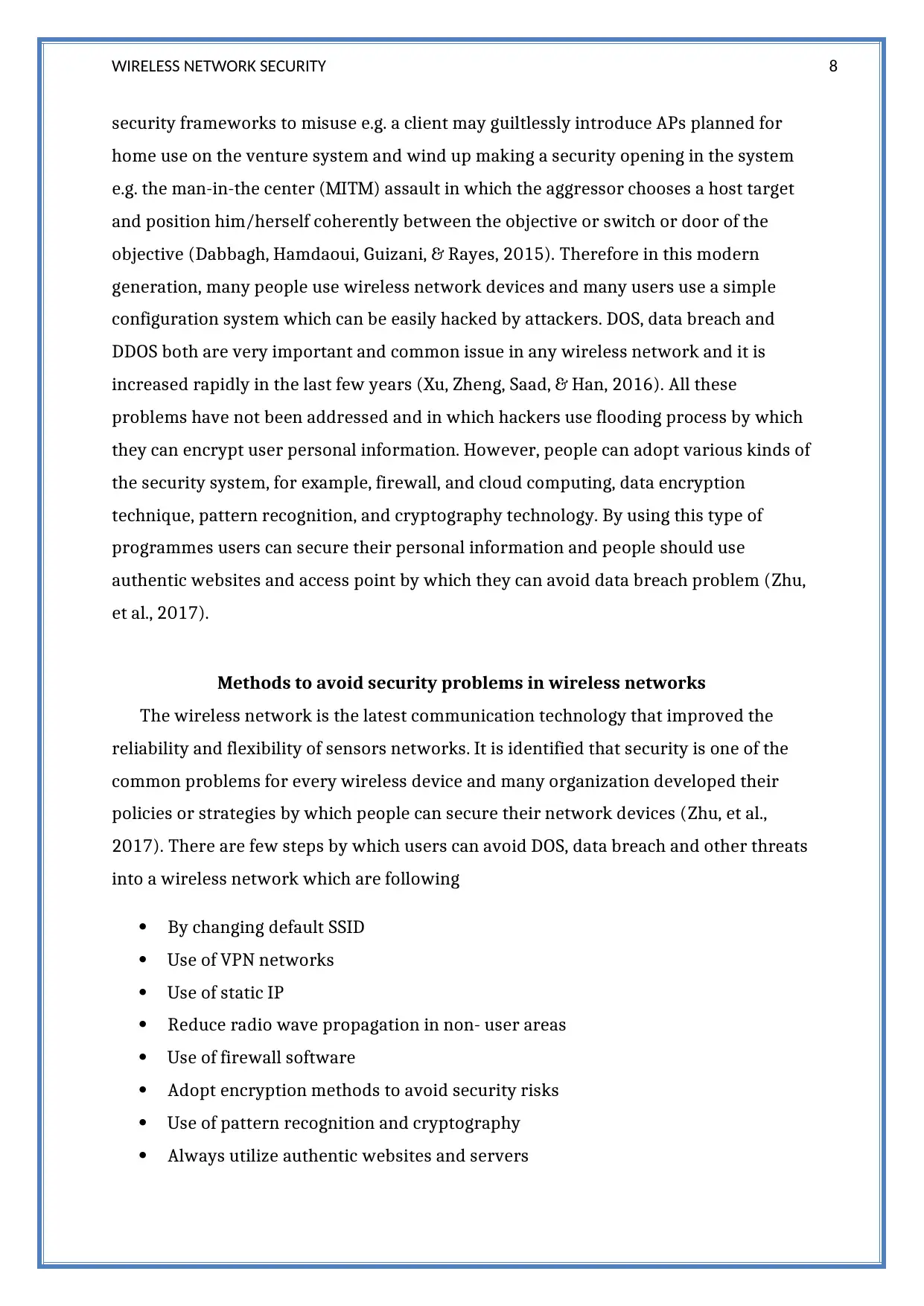
WIRELESS NETWORK SECURITY 8
security frameworks to misuse e.g. a client may guiltlessly introduce APs planned for
home use on the venture system and wind up making a security opening in the system
e.g. the man-in-the center (MITM) assault in which the aggressor chooses a host target
and position him/herself coherently between the objective or switch or door of the
objective (Dabbagh, Hamdaoui, Guizani, & Rayes, 2015). Therefore in this modern
generation, many people use wireless network devices and many users use a simple
configuration system which can be easily hacked by attackers. DOS, data breach and
DDOS both are very important and common issue in any wireless network and it is
increased rapidly in the last few years (Xu, Zheng, Saad, & Han, 2016). All these
problems have not been addressed and in which hackers use flooding process by which
they can encrypt user personal information. However, people can adopt various kinds of
the security system, for example, firewall, and cloud computing, data encryption
technique, pattern recognition, and cryptography technology. By using this type of
programmes users can secure their personal information and people should use
authentic websites and access point by which they can avoid data breach problem (Zhu,
et al., 2017).
Methods to avoid security problems in wireless networks
The wireless network is the latest communication technology that improved the
reliability and flexibility of sensors networks. It is identified that security is one of the
common problems for every wireless device and many organization developed their
policies or strategies by which people can secure their network devices (Zhu, et al.,
2017). There are few steps by which users can avoid DOS, data breach and other threats
into a wireless network which are following
By changing default SSID
Use of VPN networks
Use of static IP
Reduce radio wave propagation in non- user areas
Use of firewall software
Adopt encryption methods to avoid security risks
Use of pattern recognition and cryptography
Always utilize authentic websites and servers
security frameworks to misuse e.g. a client may guiltlessly introduce APs planned for
home use on the venture system and wind up making a security opening in the system
e.g. the man-in-the center (MITM) assault in which the aggressor chooses a host target
and position him/herself coherently between the objective or switch or door of the
objective (Dabbagh, Hamdaoui, Guizani, & Rayes, 2015). Therefore in this modern
generation, many people use wireless network devices and many users use a simple
configuration system which can be easily hacked by attackers. DOS, data breach and
DDOS both are very important and common issue in any wireless network and it is
increased rapidly in the last few years (Xu, Zheng, Saad, & Han, 2016). All these
problems have not been addressed and in which hackers use flooding process by which
they can encrypt user personal information. However, people can adopt various kinds of
the security system, for example, firewall, and cloud computing, data encryption
technique, pattern recognition, and cryptography technology. By using this type of
programmes users can secure their personal information and people should use
authentic websites and access point by which they can avoid data breach problem (Zhu,
et al., 2017).
Methods to avoid security problems in wireless networks
The wireless network is the latest communication technology that improved the
reliability and flexibility of sensors networks. It is identified that security is one of the
common problems for every wireless device and many organization developed their
policies or strategies by which people can secure their network devices (Zhu, et al.,
2017). There are few steps by which users can avoid DOS, data breach and other threats
into a wireless network which are following
By changing default SSID
Use of VPN networks
Use of static IP
Reduce radio wave propagation in non- user areas
Use of firewall software
Adopt encryption methods to avoid security risks
Use of pattern recognition and cryptography
Always utilize authentic websites and servers

WIRELESS NETWORK SECURITY 9
Keep secure personal data files through cloud computing services (Zhu, et al.,
2017).
Advantages of Wireless networks
More flexible and reliable
Increased performance of the communication system
Better mobility
Cost-effective
Hotspot and VOIP facility
Disadvantages of wireless networks
Lesser range
Security issues
Slow in speed
Increased security threats and risks
Lesser control
Data can be lost (Zhu, et al., 2017).
Future research
In this present generation, various kinds of wireless networks developed, for
example, Wi-Fi, LTE, Zigbee, and IoT. In this report, we discussed challenges and threats
faced in wireless networks and many people are facing this type of problems (Zhu, et al.,
2017). IoT is an advanced wireless technology that reduced many security problems but
at that time it is not a popular innovation. In the future, this technology will avoid DOS
and data breach problems and people can communicate from peripheral devices. We
will evaluate various security programmes in the future and people can secure their
personal data or information.
Conclusion
Any wireless network use transmitter and receiver resources for communication
and it does not require any data links or cables to transfer data from the transmitter
antenna to the receiver. Therefore this is one of the best strength of this network device
Keep secure personal data files through cloud computing services (Zhu, et al.,
2017).
Advantages of Wireless networks
More flexible and reliable
Increased performance of the communication system
Better mobility
Cost-effective
Hotspot and VOIP facility
Disadvantages of wireless networks
Lesser range
Security issues
Slow in speed
Increased security threats and risks
Lesser control
Data can be lost (Zhu, et al., 2017).
Future research
In this present generation, various kinds of wireless networks developed, for
example, Wi-Fi, LTE, Zigbee, and IoT. In this report, we discussed challenges and threats
faced in wireless networks and many people are facing this type of problems (Zhu, et al.,
2017). IoT is an advanced wireless technology that reduced many security problems but
at that time it is not a popular innovation. In the future, this technology will avoid DOS
and data breach problems and people can communicate from peripheral devices. We
will evaluate various security programmes in the future and people can secure their
personal data or information.
Conclusion
Any wireless network use transmitter and receiver resources for communication
and it does not require any data links or cables to transfer data from the transmitter
antenna to the receiver. Therefore this is one of the best strength of this network device
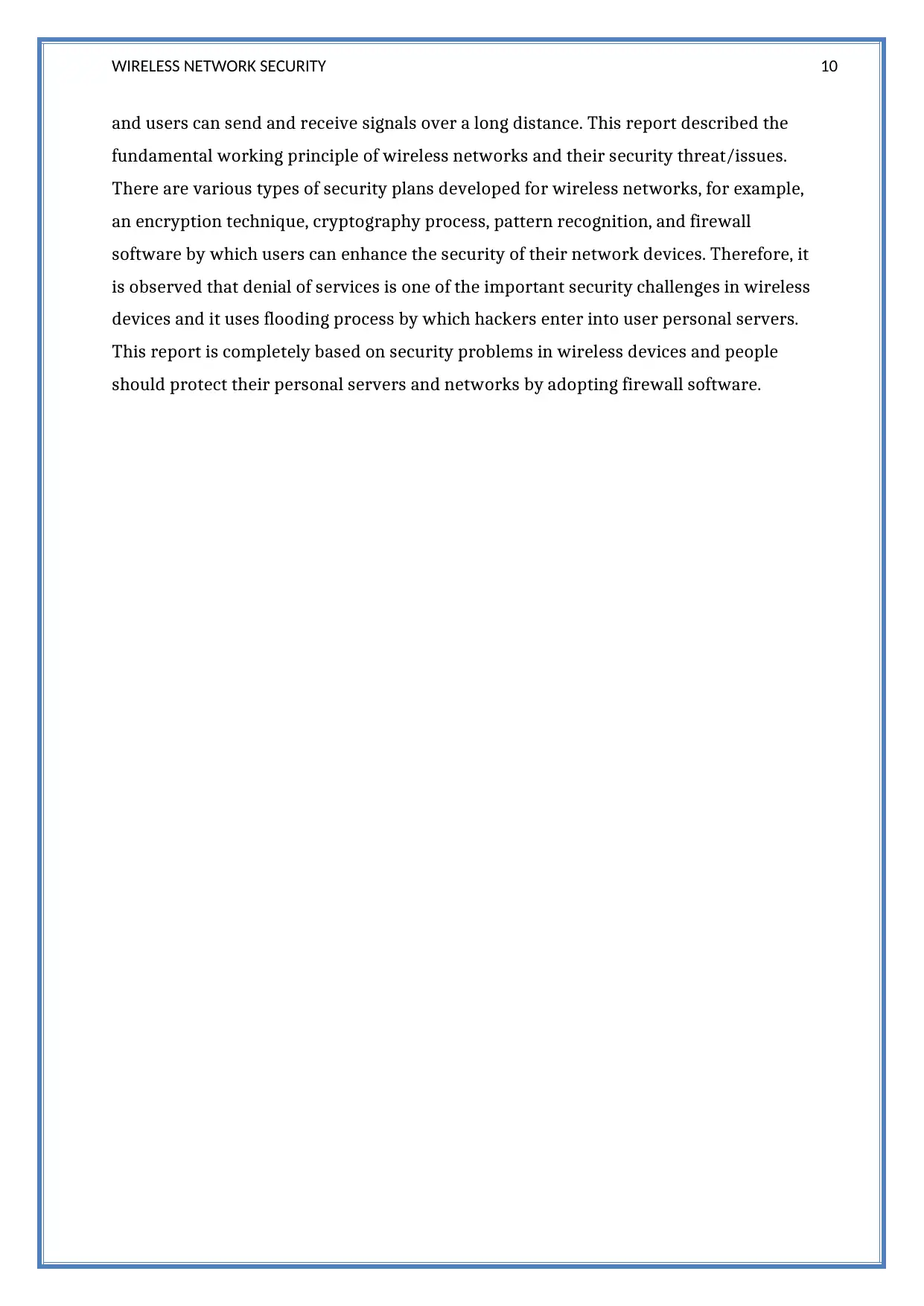
WIRELESS NETWORK SECURITY 10
and users can send and receive signals over a long distance. This report described the
fundamental working principle of wireless networks and their security threat/issues.
There are various types of security plans developed for wireless networks, for example,
an encryption technique, cryptography process, pattern recognition, and firewall
software by which users can enhance the security of their network devices. Therefore, it
is observed that denial of services is one of the important security challenges in wireless
devices and it uses flooding process by which hackers enter into user personal servers.
This report is completely based on security problems in wireless devices and people
should protect their personal servers and networks by adopting firewall software.
and users can send and receive signals over a long distance. This report described the
fundamental working principle of wireless networks and their security threat/issues.
There are various types of security plans developed for wireless networks, for example,
an encryption technique, cryptography process, pattern recognition, and firewall
software by which users can enhance the security of their network devices. Therefore, it
is observed that denial of services is one of the important security challenges in wireless
devices and it uses flooding process by which hackers enter into user personal servers.
This report is completely based on security problems in wireless devices and people
should protect their personal servers and networks by adopting firewall software.
Secure Best Marks with AI Grader
Need help grading? Try our AI Grader for instant feedback on your assignments.
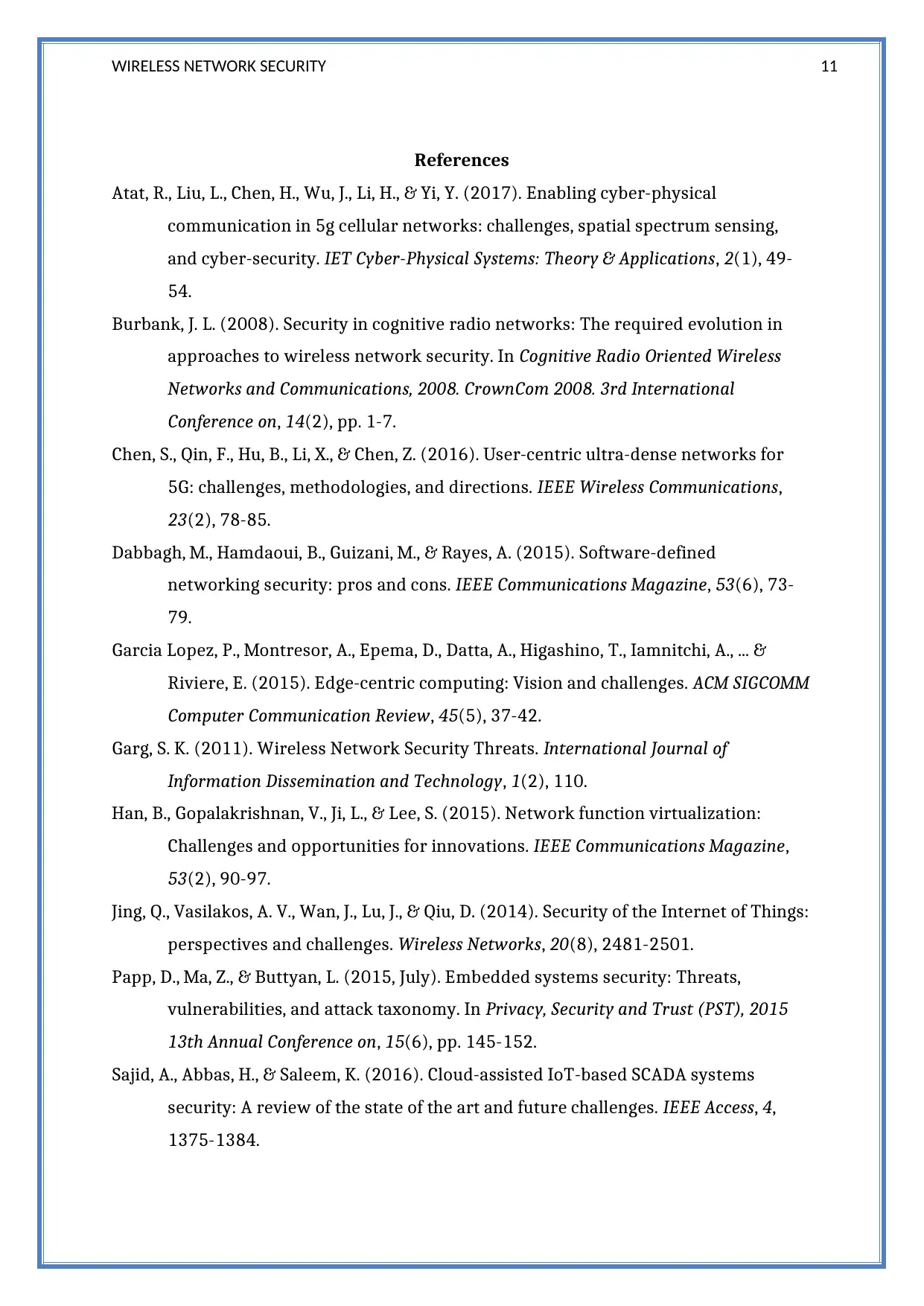
WIRELESS NETWORK SECURITY 11
References
Atat, R., Liu, L., Chen, H., Wu, J., Li, H., & Yi, Y. (2017). Enabling cyber-physical
communication in 5g cellular networks: challenges, spatial spectrum sensing,
and cyber-security. IET Cyber-Physical Systems: Theory & Applications, 2(1), 49-
54.
Burbank, J. L. (2008). Security in cognitive radio networks: The required evolution in
approaches to wireless network security. In Cognitive Radio Oriented Wireless
Networks and Communications, 2008. CrownCom 2008. 3rd International
Conference on, 14(2), pp. 1-7.
Chen, S., Qin, F., Hu, B., Li, X., & Chen, Z. (2016). User-centric ultra-dense networks for
5G: challenges, methodologies, and directions. IEEE Wireless Communications,
23(2), 78-85.
Dabbagh, M., Hamdaoui, B., Guizani, M., & Rayes, A. (2015). Software-defined
networking security: pros and cons. IEEE Communications Magazine, 53(6), 73-
79.
Garcia Lopez, P., Montresor, A., Epema, D., Datta, A., Higashino, T., Iamnitchi, A., ... &
Riviere, E. (2015). Edge-centric computing: Vision and challenges. ACM SIGCOMM
Computer Communication Review, 45(5), 37-42.
Garg, S. K. (2011). Wireless Network Security Threats. International Journal of
Information Dissemination and Technology, 1(2), 110.
Han, B., Gopalakrishnan, V., Ji, L., & Lee, S. (2015). Network function virtualization:
Challenges and opportunities for innovations. IEEE Communications Magazine,
53(2), 90-97.
Jing, Q., Vasilakos, A. V., Wan, J., Lu, J., & Qiu, D. (2014). Security of the Internet of Things:
perspectives and challenges. Wireless Networks, 20(8), 2481-2501.
Papp, D., Ma, Z., & Buttyan, L. (2015, July). Embedded systems security: Threats,
vulnerabilities, and attack taxonomy. In Privacy, Security and Trust (PST), 2015
13th Annual Conference on, 15(6), pp. 145-152.
Sajid, A., Abbas, H., & Saleem, K. (2016). Cloud-assisted IoT-based SCADA systems
security: A review of the state of the art and future challenges. IEEE Access, 4,
1375-1384.
References
Atat, R., Liu, L., Chen, H., Wu, J., Li, H., & Yi, Y. (2017). Enabling cyber-physical
communication in 5g cellular networks: challenges, spatial spectrum sensing,
and cyber-security. IET Cyber-Physical Systems: Theory & Applications, 2(1), 49-
54.
Burbank, J. L. (2008). Security in cognitive radio networks: The required evolution in
approaches to wireless network security. In Cognitive Radio Oriented Wireless
Networks and Communications, 2008. CrownCom 2008. 3rd International
Conference on, 14(2), pp. 1-7.
Chen, S., Qin, F., Hu, B., Li, X., & Chen, Z. (2016). User-centric ultra-dense networks for
5G: challenges, methodologies, and directions. IEEE Wireless Communications,
23(2), 78-85.
Dabbagh, M., Hamdaoui, B., Guizani, M., & Rayes, A. (2015). Software-defined
networking security: pros and cons. IEEE Communications Magazine, 53(6), 73-
79.
Garcia Lopez, P., Montresor, A., Epema, D., Datta, A., Higashino, T., Iamnitchi, A., ... &
Riviere, E. (2015). Edge-centric computing: Vision and challenges. ACM SIGCOMM
Computer Communication Review, 45(5), 37-42.
Garg, S. K. (2011). Wireless Network Security Threats. International Journal of
Information Dissemination and Technology, 1(2), 110.
Han, B., Gopalakrishnan, V., Ji, L., & Lee, S. (2015). Network function virtualization:
Challenges and opportunities for innovations. IEEE Communications Magazine,
53(2), 90-97.
Jing, Q., Vasilakos, A. V., Wan, J., Lu, J., & Qiu, D. (2014). Security of the Internet of Things:
perspectives and challenges. Wireless Networks, 20(8), 2481-2501.
Papp, D., Ma, Z., & Buttyan, L. (2015, July). Embedded systems security: Threats,
vulnerabilities, and attack taxonomy. In Privacy, Security and Trust (PST), 2015
13th Annual Conference on, 15(6), pp. 145-152.
Sajid, A., Abbas, H., & Saleem, K. (2016). Cloud-assisted IoT-based SCADA systems
security: A review of the state of the art and future challenges. IEEE Access, 4,
1375-1384.
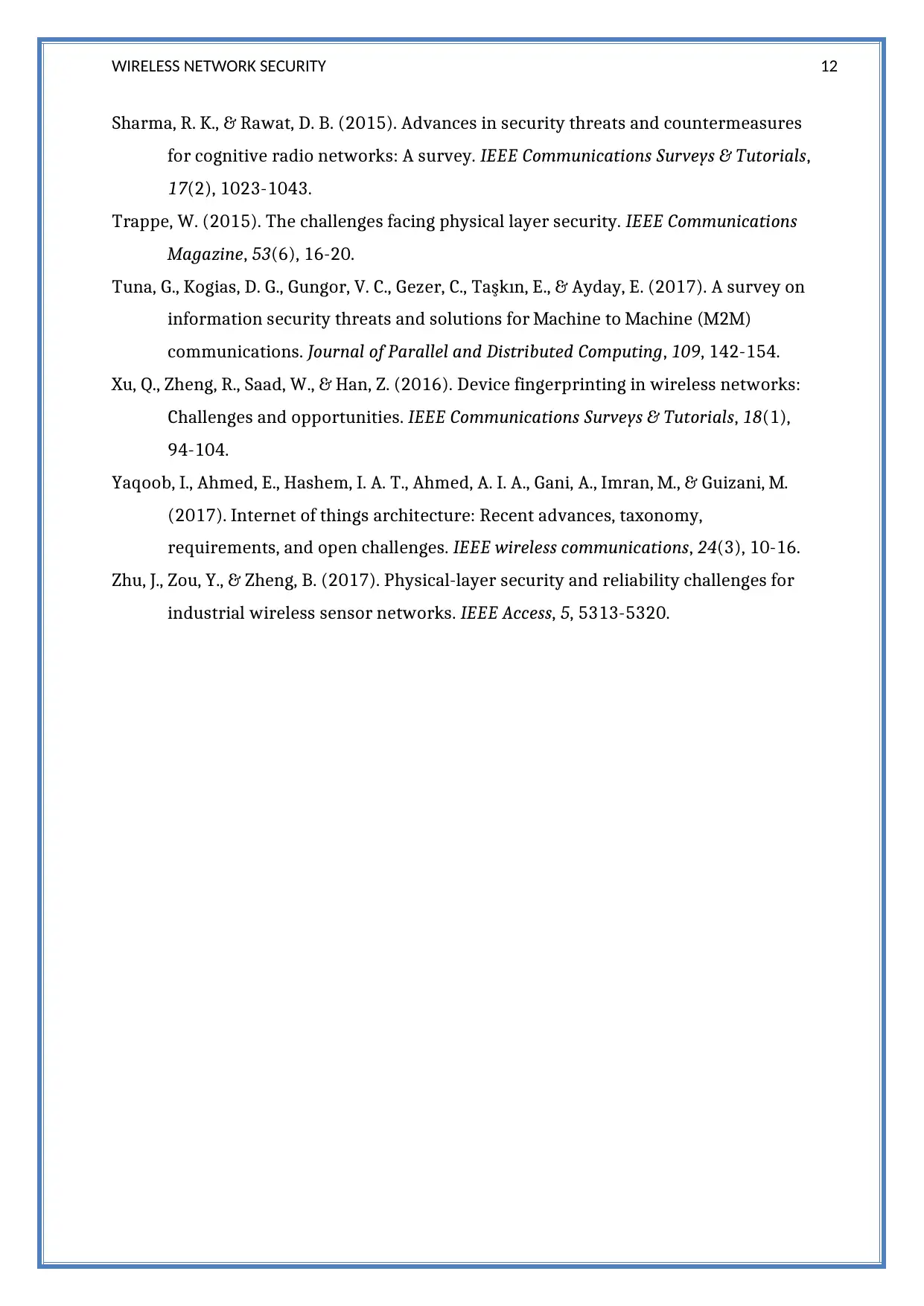
WIRELESS NETWORK SECURITY 12
Sharma, R. K., & Rawat, D. B. (2015). Advances in security threats and countermeasures
for cognitive radio networks: A survey. IEEE Communications Surveys & Tutorials,
17(2), 1023-1043.
Trappe, W. (2015). The challenges facing physical layer security. IEEE Communications
Magazine, 53(6), 16-20.
Tuna, G., Kogias, D. G., Gungor, V. C., Gezer, C., Taşkın, E., & Ayday, E. (2017). A survey on
information security threats and solutions for Machine to Machine (M2M)
communications. Journal of Parallel and Distributed Computing, 109, 142-154.
Xu, Q., Zheng, R., Saad, W., & Han, Z. (2016). Device fingerprinting in wireless networks:
Challenges and opportunities. IEEE Communications Surveys & Tutorials, 18(1),
94-104.
Yaqoob, I., Ahmed, E., Hashem, I. A. T., Ahmed, A. I. A., Gani, A., Imran, M., & Guizani, M.
(2017). Internet of things architecture: Recent advances, taxonomy,
requirements, and open challenges. IEEE wireless communications, 24(3), 10-16.
Zhu, J., Zou, Y., & Zheng, B. (2017). Physical-layer security and reliability challenges for
industrial wireless sensor networks. IEEE Access, 5, 5313-5320.
Sharma, R. K., & Rawat, D. B. (2015). Advances in security threats and countermeasures
for cognitive radio networks: A survey. IEEE Communications Surveys & Tutorials,
17(2), 1023-1043.
Trappe, W. (2015). The challenges facing physical layer security. IEEE Communications
Magazine, 53(6), 16-20.
Tuna, G., Kogias, D. G., Gungor, V. C., Gezer, C., Taşkın, E., & Ayday, E. (2017). A survey on
information security threats and solutions for Machine to Machine (M2M)
communications. Journal of Parallel and Distributed Computing, 109, 142-154.
Xu, Q., Zheng, R., Saad, W., & Han, Z. (2016). Device fingerprinting in wireless networks:
Challenges and opportunities. IEEE Communications Surveys & Tutorials, 18(1),
94-104.
Yaqoob, I., Ahmed, E., Hashem, I. A. T., Ahmed, A. I. A., Gani, A., Imran, M., & Guizani, M.
(2017). Internet of things architecture: Recent advances, taxonomy,
requirements, and open challenges. IEEE wireless communications, 24(3), 10-16.
Zhu, J., Zou, Y., & Zheng, B. (2017). Physical-layer security and reliability challenges for
industrial wireless sensor networks. IEEE Access, 5, 5313-5320.
1 out of 12
Related Documents
Your All-in-One AI-Powered Toolkit for Academic Success.
+13062052269
info@desklib.com
Available 24*7 on WhatsApp / Email
![[object Object]](/_next/static/media/star-bottom.7253800d.svg)
Unlock your academic potential
© 2024 | Zucol Services PVT LTD | All rights reserved.




